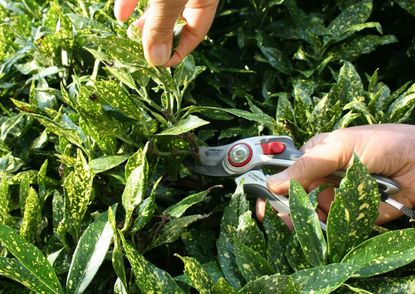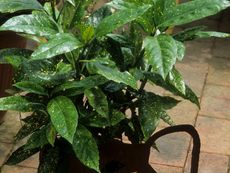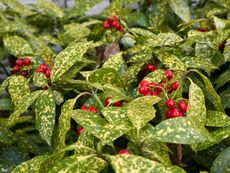Aucuba Pruning - How And When To Prune Aucuba Shrubs


One of the most attractive home landscape plants is the Aucuba japonica. This slow-growing foliage plant assumes a shrub-like habit with glossy, pointed leaves and graceful, arching stems. The blood red berries will persist on the female plant throughout winter and proper knowledge of how to prune an aucuba can assist in consistent fruiting.
About Aucuba japonica
Aucuba is not native to North America but does perform well in USDA plant hardiness zones 7 through 9. This ornamental shrub can be used singly as a focal point for the landscape, planted in groups as a hedge, or used in containers when young. Japanese aucuba plants are also sometimes referred to as Japanese laurels because of their similar shiny, waxy leaves. There are many surprising cultivars available, which delight with a host of variances in pigment and texture. Some of the more common ones include:
- Crotonifolia has white spotted leaves
- Goldieana has predominantly yellow leaves
- Gold Dust (or Variegata) has gold flecks
- Nana is a dwarf form with a tight form and low habit
Growing Japanese Aucuba Plant Cuttings
The shrub grows 3 to 8 feet (1-2.5 m.) tall but takes years to achieve full maturity. This slow, growth habit means aucuba pruning is seldom necessary. However, you should pay attention to when to prune aucuba to keep the dense form and use the cuttings to propagate new plants to enliven the landscape. Dip the cut ends into rooting hormone and push them into a soilless medium, such as peat moss. Keep the plant in a warm, dimly lit area with light moisture. Transplant the cutting as soon as it has rooted. Aucuba japonica will flourish in organically rich soils where dappled lighting is offered. The Japanese aucuba plant prefers a partially shaded location where soils are slightly acidic and moist, but well-drained.
When to Prune Aucuba
Due to the slow growth rate, Aucuba japonica rarely requires trimming. Although the plant needs little maintenance, it does respond well to pruning to maintain size and a compact form. The plant is a broadleaf evergreen, which should be pruned in early spring for best results. Light branch tipping or removal of dead wood can be done at any point in the year. A complete overhaul of a neglected Japanese aucuba plant is done in very early spring before new growth begins. Refrain from fertilizing the plant prior to pruning to reduce the formation of young growth, which would only be cut off during the trimming process.
How to Prune an Aucuba
Aucuba pruning on young plants may only require a thumb and forefinger. Pinching off tip growth will help promote bushiness. Use sharp, clean pruners for any maintenance project to ensure straight cuts and reduce the chance of disease introduction. Hand pruners are useful for removing errant growth and trimming back the stems to reduce the height of the shrub. Remove the growth to the next growing point for the best results. Hedge trimmers are not recommended as they cut into the gorgeous leaves and reduce the ornamental value of the plant.
Gardening tips, videos, info and more delivered right to your inbox!
Sign up for the Gardening Know How newsletter today and receive a free download of our most popular eBook "How to Grow Delicious Tomatoes."

Bonnie Grant is a professional landscaper with a Certification in Urban Gardening. She has been gardening and writing for 15 years. A former professional chef, she has a passion for edible landscaping.
-
 Grow a Bathroom Oasis: 8 Best Bathroom Plants With No Light or Low Light
Grow a Bathroom Oasis: 8 Best Bathroom Plants With No Light or Low LightSome apartment dwellers grow the best bathroom plants with no light or low light. Read how one of our favorite plant lovers does it in the big city.
By Teo Spengler
-
 "My Worst Mistake" – Gardeners Share 10 Hard-Learned Lessons
"My Worst Mistake" – Gardeners Share 10 Hard-Learned LessonsGardeners never stop learning, and sometimes our mistakes are the best teachers. But why not save time and heartache by learning from other gardeners' failures?
By Melanie Griffiths
-
 Container Grown Aucuba Shrubs: Can You Grow Japanese Laurel In A Pot
Container Grown Aucuba Shrubs: Can You Grow Japanese Laurel In A PotCan you grow Japanese laurel in a pot? Growing Japanese aucuba in containers is no problem. To learn more about container grown aucuba shrubs, the following article provides helpful information.
By Mary H. Dyer
-
 Japanese Aucuba Propagation - How To Root Aucuba Cuttings
Japanese Aucuba Propagation - How To Root Aucuba CuttingsAucuba is a lovely shrub that seems to almost glitter in the shade. Propagating aucuba cuttings is a snap. Find out how to root aucuba cuttings in this article. Click this article to get more Japanese aucuba propagation information.
By Jackie Carroll
-
 Aucuba Plant Care: Learn About Aucuba Growing Conditions
Aucuba Plant Care: Learn About Aucuba Growing ConditionsPerfect for shady areas that need a touch of color, the Japanese aucuba plant brightens dark spots in the landscape with large leaves that are flecked with yellow-gold. Read this article to find out how to grow and care for aucuba plants.
By Jackie Carroll